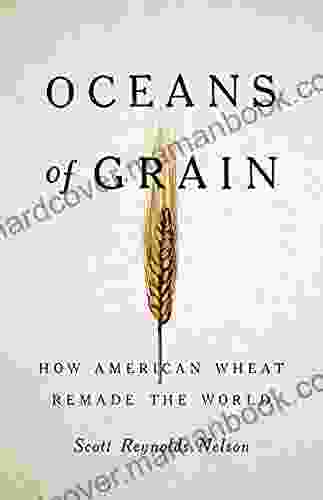How American Wheat Remade The World: A Comprehensive Exploration of the Profound Impact of American Wheat on Global Society

: The Seeds of a Transformation
Wheat, a humble yet vital grain, has played an integral role in shaping human history. Its cultivation and consumption have sustained civilizations for millennia, providing nourishment and sustenance to countless lives. Among the world's wheat producers, the United States stands as a beacon, its vast fields and innovative farming practices transforming not only its own nation but the global landscape. This article delves into the remarkable story of American wheat and its far-reaching impact on the world.
The American Wheat Belt: A Vast Breadbasket
The Great Plains of North America, stretching from the Gulf of Mexico to the Canadian border, form the heartland of American wheat production. This vast expanse of fertile land, known as the Wheat Belt, has endowed the United States with an unparalleled capacity for wheat cultivation. Rich soils, ample rainfall, and temperate climate provide ideal conditions for the growth of this essential grain.
4.1 out of 5
| Language | : | English |
| File size | : | 4458 KB |
| Text-to-Speech | : | Enabled |
| Screen Reader | : | Supported |
| Enhanced typesetting | : | Enabled |
| Word Wise | : | Enabled |
| Print length | : | 369 pages |
The development of the Wheat Belt was a complex and transformative process. Following the Louisiana Purchase in 1803, settlers began to pour into the Great Plains, lured by the promise of cheap land and abundant opportunities. With the advent of new technologies such as the steel plow and the combine harvester, farmers were able to cultivate vast tracts of land and reap bountiful harvests.
Feeding the World: The Rise of American Wheat Exports
As the United States' wheat production soared, so too did its exports. In the late 19th and early 20th centuries, American wheat became a staple food in Europe, where industrialization was creating a growing demand for bread and other wheat-based products. The United Kingdom, Germany, and France were among the largest importers of American wheat, relying on its high quality and affordability to feed their urban populations.
World War I further amplified the demand for American wheat. As millions of men were drafted into military service, the need for sustenance on both sides of the Atlantic grew exponentially. The United States emerged as a major supplier of food to the Allies, including wheat, flour, and other essential commodities.
Industrialization and Innovation: The Transformation of the Wheat Industry
The rise of American wheat exports was closely intertwined with the development of industrialized farming practices. Technologies like the steam engine and the tractor revolutionized agricultural production, enabling farmers to cultivate larger areas with greater efficiency. The invention of the grain elevator and the flour mill further streamlined the process of harvesting, storing, and milling wheat.
Alongside technological advancements, scientific research played a crucial role in boosting American wheat yields. The establishment of agricultural research stations and universities led to the development of new and improved wheat varieties, resistant to pests and diseases and capable of producing higher yields.
The Globalization of American Wheat: A Culinary Revolution
American wheat not only sustained nations but also left an indelible mark on global cuisine. The of American wheat flour into Europe revolutionized bread-making techniques, leading to the development of new bread styles, including the classic French baguette.
In Asia, American wheat was embraced as an affordable alternative to local grains. It became a staple ingredient in noodles, pastries, and other traditional dishes, introducing a new dimension to Asian cuisine.
The Impact on Global Trade and Economics
The global wheat trade, driven in large part by American exports, has shaped international trade patterns and economic development. The United States emerged as a dominant player in the global grain market, with its wheat exports influencing prices and shaping food security policies around the world.
The wheat trade also facilitated the transfer of wealth and technology between nations. Wheat-importing countries invested in infrastructure and transportation systems to facilitate the import and distribution of grain. In return, the United States benefited economically from its wheat exports, using the proceeds to purchase other goods and services from abroad.
Social and Cultural Transformations: The Wheat Frontier
The expansion of the American Wheat Belt had a profound impact on the social and cultural fabric of the United States. Homesteaders and farmers flocked to the Great Plains, creating new communities and transforming the demographics of the region. The wheat industry fostered a sense of community and cooperation, with farmers banding together to build grain elevators, establish schools, and support local businesses.
The wheat frontier also attracted immigrants from across the globe, seeking a better life and the opportunity to own land. Germans, Scandinavians, and Eastern Europeans brought their traditions and customs to the Great Plains, enriching the cultural heritage of the region.
Challenges and Controversies: The Darker Side of Wheat
The rise of American wheat was not without its challenges and controversies. The rapid expansion of wheat farming in the Great Plains led to environmental concerns, including soil erosion and the depletion of water resources. The use of chemical fertilizers and pesticides raised questions about the long-term sustainability of wheat production.
Labor disputes and social unrest marked the history of the wheat industry. Farmers struggled to secure fair prices for their crops, leading to strikes and protests. The plight of migrant workers, who often faced harsh working conditions and low wages, also cast a shadow over the industry.
: A Legacy of Nourishment and Transformation
The story of American wheat is a testament to the transformative power of agriculture. From its humble beginnings in the Great Plains to its global impact on food security, economics, and culture, American wheat has played a pivotal role in shaping the world we live in today.
As we face the challenges of the 21st century, including climate change and population growth, the lessons learned from the history of American wheat are more relevant than ever. By embracing sustainable farming practices, investing in research and innovation, and promoting fair trade, we can harness the power of agriculture to feed the world and build a more just and prosperous future.
Additional Resources:
* The Wheat Belt and Its Impact on American Society * The Role of American Wheat in World War I * The Globalization of American Wheat and Its Influence on World Cuisine * The Social and Cultural Impact of the Wheat Frontier * The Challenges and Controversies of the American Wheat Industry
4.1 out of 5
| Language | : | English |
| File size | : | 4458 KB |
| Text-to-Speech | : | Enabled |
| Screen Reader | : | Supported |
| Enhanced typesetting | : | Enabled |
| Word Wise | : | Enabled |
| Print length | : | 369 pages |
Do you want to contribute by writing guest posts on this blog?
Please contact us and send us a resume of previous articles that you have written.
 Top Book
Top Book Novel
Novel Fiction
Fiction Nonfiction
Nonfiction Literature
Literature Paperback
Paperback Hardcover
Hardcover E-book
E-book Audiobook
Audiobook Bestseller
Bestseller Classic
Classic Mystery
Mystery Thriller
Thriller Romance
Romance Fantasy
Fantasy Science Fiction
Science Fiction Biography
Biography Memoir
Memoir Autobiography
Autobiography Poetry
Poetry Drama
Drama Historical Fiction
Historical Fiction Self-help
Self-help Young Adult
Young Adult Childrens Books
Childrens Books Graphic Novel
Graphic Novel Anthology
Anthology Series
Series Encyclopedia
Encyclopedia Reference
Reference Guidebook
Guidebook Textbook
Textbook Workbook
Workbook Journal
Journal Diary
Diary Manuscript
Manuscript Folio
Folio Pulp Fiction
Pulp Fiction Short Stories
Short Stories Fairy Tales
Fairy Tales Fables
Fables Mythology
Mythology Philosophy
Philosophy Religion
Religion Spirituality
Spirituality Essays
Essays Critique
Critique Commentary
Commentary Glossary
Glossary Bibliography
Bibliography Index
Index Table of Contents
Table of Contents Preface
Preface Introduction
Introduction Foreword
Foreword Afterword
Afterword Appendices
Appendices Annotations
Annotations Footnotes
Footnotes Epilogue
Epilogue Prologue
Prologue Jennifer Chiaverini
Jennifer Chiaverini Terra Weiss
Terra Weiss Michael Ediale
Michael Ediale Emily Ryan
Emily Ryan Helena Rookwood
Helena Rookwood Elouise Tynan
Elouise Tynan Ram V
Ram V Ernest Dempsey
Ernest Dempsey Elon Gaezos
Elon Gaezos Peter R Hall
Peter R Hall Tom Hall
Tom Hall Rachel Dodman
Rachel Dodman Marcus Buckingham
Marcus Buckingham Steven J Taylor
Steven J Taylor Keith Taylor
Keith Taylor Aaron Pery
Aaron Pery Red Pesca
Red Pesca Christopher Williams
Christopher Williams Geraldine Powell
Geraldine Powell Jeremy Taylor
Jeremy Taylor
Light bulbAdvertise smarter! Our strategic ad space ensures maximum exposure. Reserve your spot today!

 Glenn HayesThe Enchanting Ladino Verses of Bouena Sarfatty: A Tapestry of Sephardi and...
Glenn HayesThe Enchanting Ladino Verses of Bouena Sarfatty: A Tapestry of Sephardi and... Tom ClancyFollow ·11.5k
Tom ClancyFollow ·11.5k Francis TurnerFollow ·15.4k
Francis TurnerFollow ·15.4k Junot DíazFollow ·13.2k
Junot DíazFollow ·13.2k Aldous HuxleyFollow ·6.9k
Aldous HuxleyFollow ·6.9k Tyler NelsonFollow ·13.5k
Tyler NelsonFollow ·13.5k Dan BrownFollow ·17.1k
Dan BrownFollow ·17.1k Willie BlairFollow ·18.5k
Willie BlairFollow ·18.5k Carter HayesFollow ·13.3k
Carter HayesFollow ·13.3k

 Eugene Powell
Eugene PowellComplete Guide to Using Yoga With Kids: Benefits, Tips,...
Yoga is an ancient practice that has been...

 Benji Powell
Benji PowellHow to Make $000 Per Week on Craigslist
Are you looking for a way to make extra money...

 Gabriel Garcia Marquez
Gabriel Garcia MarquezGrocery Row Gardening: The Exciting New Permaculture...
Kick-start your gardening journey with the...

 Hayden Mitchell
Hayden MitchellUnveiling the Gripping World of Winterwood: Ben Hood...
In the annals of crime thrillers, the...

 E.M. Forster
E.M. ForsterThe Financial Advisor Guide To Managing and Investing...
As a financial...

 Lee Simmons
Lee SimmonsIn My Shoes Memoir: A Poignant Journey of Resilience,...
In the tapestry of life, adversity often...
4.1 out of 5
| Language | : | English |
| File size | : | 4458 KB |
| Text-to-Speech | : | Enabled |
| Screen Reader | : | Supported |
| Enhanced typesetting | : | Enabled |
| Word Wise | : | Enabled |
| Print length | : | 369 pages |










